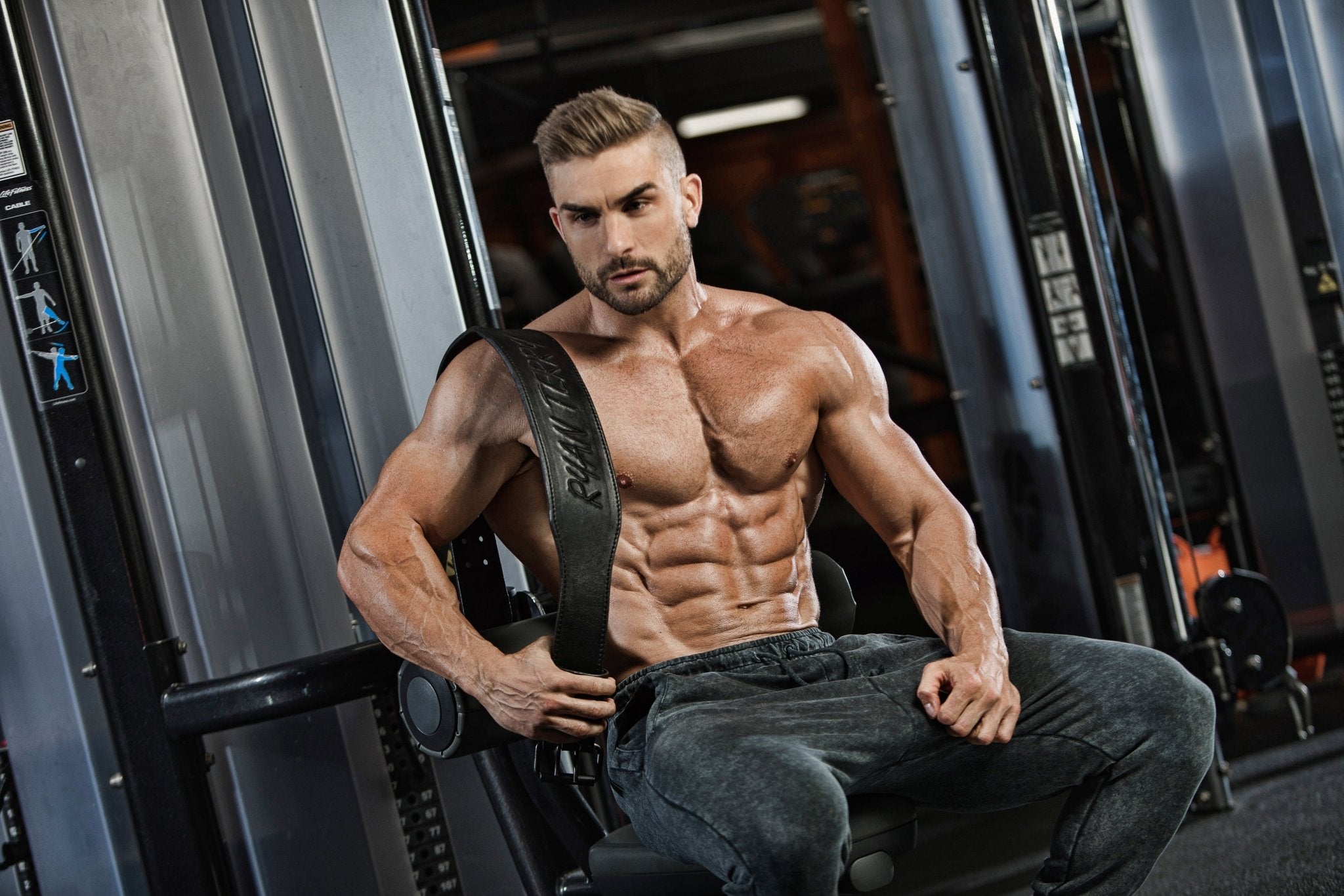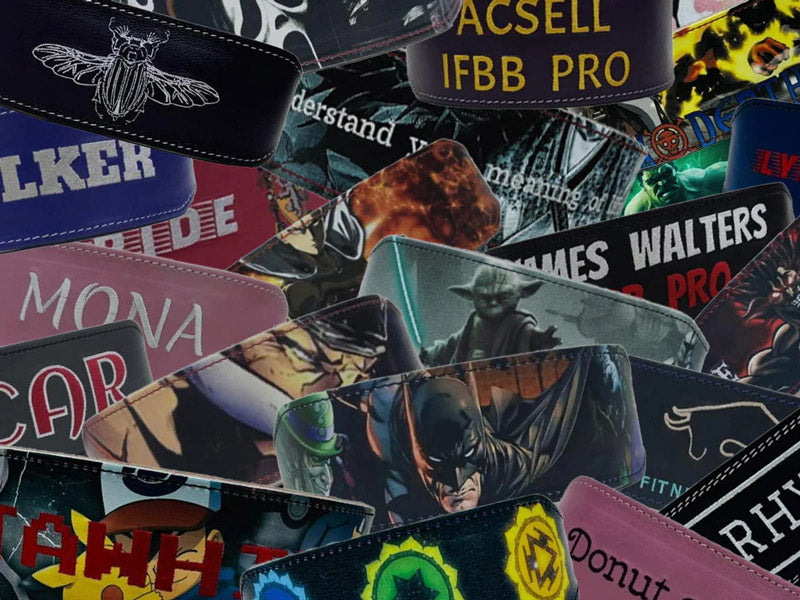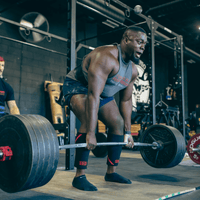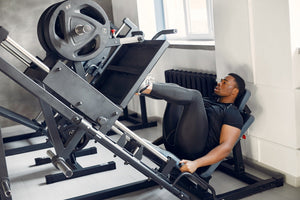
Do I Need a Weightlifting Belt in 2025? Benefits and Best Practices
Weightlifting belts have long been a staple in gyms and among serious lifters. They’re often spotted wrapped around powerlifters, bodybuilders, and the occasional daily gym-goer. But are these belts just trendy accessories, or do they serve a genuine purpose?
Hint: it’s the latter.
Weightlifting belts can help prevent injury, add more weight to your squats and deadlifts, and more. In this article, you’ll learn all you need to know about weightlifting belts, including when you need to use one, what the benefits are, and more.
Here’s what we’re going to cover:
- Why Weightlifting Belts Are So Important
- Exercises That Benefit From a Weightlifting Belt
- 4 Things to Consider When Choosing a Weightlifting Belt
And more!
Let’s dive right in.

Check out our premium lifting belts.
Do I Need A Weightlifting Belt?
Yes, you need a weightlifting belt to improve your performance and safety during heavy lifting exercises. A weightlifting belt is designed to:
- Stabilise and support your lower back and core.
- Reduce the risk of injury and
- Improve your ability to lift heavier weights.
Other perks are:
- A belt helps increase intra-abdominal pressure, providing additional support to your spine.
- It encourages proper posture and form, which are crucial for preventing injuries.
- Many lifters find they can lift more weight with a belt, as it provides a sense of security and stability.
- Using a lifting belt reduces the risk of injuries by providing support to the lower back and core muscles.
What Are the Benefits of Using a Weightlifting Belt?
If you’ve ever wondered why so many bodybuilders strap on a weightlifting belt, it’s because these belts offer unmatched advantages, especially for intermediate to advanced lifters.
Most weightlifters wouldn’t get under a heavy barbell for some deep squats without a belt on. As the weight you lift grows, so does the need for a belt to ensure safety.
Here are six essential reasons why you should be using a weightlifting belt:
1. Prevents Injury When Training
A lifting belt protects your body, especially when you’re pushing your limits with hefty weights. These belts stabilise the spine by increasing intra-abdominal pressure. This additional support not only reduces stress on the vertebrae and intervertebral discs but also ensures you maintain optimal posture during lifts.
Maintaining a neutral spine is integral in lifting techniques, which is exactly what a lifting belt helps you achieve. By doing so, it reduces the chances of hyperextension or hyperflexion.
2. Provides More Weight When Squatting & Deadlifting
Weightlifting belts can be a game-changer when it comes to maximising your strength potential.
The support and stability that lifting belts offer can increase the weight you’re able to lift. In fact, many trained athletes have reported a noteworthy boost in their performance shortly after incorporating a belt into their routine.
Specifically, within one to two weeks of using a belt, athletes often experience a 5 - 15% increase in their maximum lifting capacity. This improvement underscores the belt’s role in safety and improving overall performance in lifts like squats and deadlifts.
3. Break Plateaus & One-Repetition Maximum
For many trainees, hitting a plateau can be discouraging and create a sense of stagnation in their progress. This is exactly why incorporating a weightlifting belt into your regimen can provide the extra boost needed to overcome these barriers.
When you’re chasing a new one-rep max personal record, a weightlifting belt can be a game-changer. The additional core support and spinal stabilisation often turn a seemingly impossible lift into a triumphant achievement. Many lifters report immediate strength increases of 5-15% on their maximal lifts when properly using a belt for the first time.
Beyond physical strength, the practice of weightlifting also offers resilience and discipline, as it has a positive impact on one’s mental health. As a result, using a weightlifting belt can give lifters the confidence and support they need to take their performance to the next level.
4. Improves Biomechanics When Strength Training
Research has shown that weightlifting belts help ensure ideal biomechanics when engaging in foundational exercises, such as squats and deadlifts. This improvement occurs in several specific ways:
First, using a belt reduces unwanted spinal movements during heavy lifts. It minimises excessive extension (arching), flexion (rounding), and, to a lesser extent, lateral flexion (side-bending) of the spine. By limiting these potentially dangerous movements, the belt helps keep your spine in its strongest and safest neutral position throughout the entire range of motion.
Second, wearing a belt encourages lifters to shift more of the workload to their legs rather than overusing their back muscles. This happens because the increased intra-abdominal pressure created by bracing against the belt promotes better overall body positioning. You’ll notice that with a belt, you naturally drive more with your legs and maintain a more upright posture.
This biomechanical shift offers significant strategic advantages for both performance and recovery. This improvement underscores the belt’s role in safety and improving overall performance in lifts like squats and deadlifts. They can handle heavier loads and recover more quickly than smaller muscle groups, such as those in your lower back.
5. Less Stress On The Spine
Using a weightlifting belt during your training routine increases intra-abdominal pressure. This actively counteracts and lowers the compression forces that work on your lower back discs.
By doing so, the amount of stress on the lumbar region is reduced, in turn lowering the risk of spinal injuries.
Yet, the benefits of the belt go beyond mere spinal protection. The lifting belt also acts as a supportive brace for the abdominal muscles. This amplification in abdominal pressure isn’t just a byproduct; it’s a crucial mechanism through which the spine gains additional support, which is especially helpful when you’re lifting heavier loads.
6. Provides Better Strength Balance
For lifters who can squat or deadlift twice their body weight, a weightlifting belt becomes almost indispensable. This is because different muscle groups respond differently to training. While the legs, owing to their larger muscle mass, often exhibit rapid strength gains and development, the abs and lower back may lag.
Incorporating a weightlifting belt can effectively bridge this disparity, ensuring that the core and lower back are supported equally. In doing so, the belt helps prevent injuries and ensures even strength across the body, leading to improved lifting progress.

Check out our premium lifting belts and find the perfect match for you.
When Do I Need a Weightlifting Belt?
While weightlifting belts offer numerous benefits, knowing when to strap one on can be confusing for many lifters. You need a weightlifting belt when:
1. You’re lifting heavy loads (80 %+ of your 1RM):
When the weight gets serious, so should your approach to safety. For most lifters, this means using a belt when you’re working with weights at or above 80% of your one-rep maximum. At this intensity level, your spine is under significant stress, and the additional support becomes crucial.
2. You’re performing maximal or near-maximal compound lifts:
Exercises such as heavy squats, deadlifts, overhead presses, and power cleans greatly benefit from the use of a belt. These movements place the greatest demands on your core stability and spinal integrity, making belt support particularly valuable.
3. You’re attempting a personal record:
When pushing for a new PR, every advantage matters. The added stability and confidence a belt provides can make the difference between a successful lift and a missed attempt.
Many lifters report being able to push past plateaus when properly utilising a belt for their heaviest attempts.
4. You have a history of back issues:
If you’ve experienced lower back problems in the past, a weightlifting belt can provide the additional support needed to train safely. The increased intra-abdominal pressure helps protect vulnerable areas from excessive strain during heavy lifts.
5. You’re competing in strength sports:
If you’re training for powerlifting, strongman, or Olympic weightlifting competitions where belt use is permitted, it’s essential to train with one regularly to develop comfort and proper bracing techniques under competition conditions.
When Do I Not Need a Weightlifting Belt?
You don’t need a weightlifting belt:
1. During your initial learning phase:
Before relying on a belt, Beginners should develop natural core strength and proper movement patterns. Typically, you should have at least 6-12 months of consistent training experience before incorporating a belt.
2. For isolation or machine exercises:
Movements like bicep curls, tricep extensions, or leg curls don’t create enough spinal loading to warrant belt usage. Save it for the big compound movements.
3. During warm-up sets:
Reserve the belt for your working sets to avoid becoming dependent on it. Performing warm-ups without a belt helps activate your core naturally and prepares it for heavier loads.
4. When focusing on core development:
If your goal is to strengthen your core muscles, incorporating beltless training into at least part of your program is beneficial for developing those stabilising muscles.
Exercises That Benefit from a Weightlifting Belt

Weightlifting belts can be highly beneficial for specific exercises, particularly those that involve heavy loads, compound movements, and significant stress on the lower back and core.
Here are some key exercises where a weightlifting belt is essential:
I. Squats:
Whether you’re doing back squats or front squats, a weightlifting belt can help maintain proper spinal alignment and reduce the risk of lower back strain. For squats, it’s also helpful to combine knee sleeves with a lifting belt.
ii. Deadlifts:
Deadlifting involves lifting heavy weights from the ground, which significantly stresses your lower back. A weightlifting or deadlift belt can help you maintain a neutral spine and reduce the risk of injury. In case you’re going heavy with deadlifts, consider wearing lifting straps.
iii. Clean and Jerk:
This Olympic weightlifting movement combines power and technique to achieve optimal results. A weightlifting belt can provide stability during the most intense phases of the lift, helping you maintain a strong and secure posture.
IV. Snatch:
Similar to the clean and jerk, the snatch is another Olympic lift that demands precision and strength. A weightlifting belt can help maintain proper form and reduce the risk of injury during lifts.
v. Overhead Press:
When lifting heavy weights overhead, a belt can help stabilise your core and prevent hyperextension of your lower back.
vi. Bent-over Rows:
This exercise targets the upper back, and when heavy weights are involved, a weightlifting belt can help you maintain good posture during the movement.
A weightlifting belt can offer valuable support for these exercises, but it’s worth noting that it can’t replace proper form and technique.
Who Should Use a Weightlifting Belt?
Weightlifting belts aren’t just for elite powerlifters or competitive bodybuilders; they’re also beneficial for those who lift weights regularly. A variety of individuals can benefit from using a belt during their training sessions. Here’s a breakdown of who should consider adding a weightlifting belt to their gym bag:
1. Intermediate to Advanced Strength Athletes:
Once you’ve established a solid foundation of proper technique and core strength (typically after 6-12 months of consistent training), a weightlifting belt becomes a valuable addition to your training arsenal. At this stage, you’re likely handling weights heavy enough to benefit from the added support.
2. Powerlifters and Olympic Weightlifters:
For those competing in strength sports, a weightlifting belt is practically essential equipment. Not only is it allowed in competition, but the specific demands of maximal lifting make belt usage particularly beneficial for both performance and safety.
3. Bodybuilders During Heavy Compound Movements:
While bodybuilders focus primarily on muscle development rather than absolute strength, they still perform heavy compound exercises that benefit from the use of a belt. During sets of heavy squats, deadlifts, or overhead presses, a belt helps maintain proper form and allows for greater training intensity.
4. CrossFit Athletes:
The varied and often heavy nature of CrossFit workouts—especially those involving deadlifts, squats, and Olympic lifts—makes a weightlifting belt useful for certain WODs (Workouts of the Day). Many CrossFit athletes opt for a more versatile nylon belt that can be quickly adjusted between different exercises.
5. Individuals with Previous Back Injuries:
If you’ve experienced lower back issues in the past but have been cleared to train by a medical professional, a weightlifting belt can provide the additional support needed to return to training safely. The increased abdominal pressure helps stabilise the spine and reduces the risk of re-injury.
Note: Using a weightlifting belt effectively requires proper technique. Simply strapping on a belt without understanding how to brace against it won’t provide the intended benefits. Take the time to learn proper breathing and bracing techniques to maximise the benefits a belt offers.
4 Things To Consider When Choosing A Weightlifting Belt
So now that you have decided that you need a weightlifting belt, here are four factors you should consider when choosing one:
1. Material of the belt
Weightlifting belts typically come in three primary materials:
I. Leather Belts:
These are the gold standard for serious lifters. They’re durable, provide excellent support, and mould to your body over time. Quality leather belts can last for decades with proper care. However, they’re typically more expensive and require a break-in period.
ii. Nylon Belts:
These belts are more affordable and flexible than leather. This is why they’re often preferred by CrossFit athletes and those who need a belt that allows for greater mobility between exercises. They’re comfortable from day one, but generally don’t provide quite as much support as leather belts.
iii. Suede belt:
Suede belts offer a middle ground between leather and nylon options. They provide the rigidity and support similar to leather but with a softer, more comfortable feel against the body. The textured surface helps prevent the belt from slipping during intense movements. Suede belts are particularly popular among powerlifters who want the support of leather without the sometimes harsh edge that new leather belts can have. Like leather, suede belts will conform to your body shape over time.
Regardless of the material you choose, it’s essential to take good care of your lifting belts so they last a long time. Read our article about taking care of lifting belts to learn how to do it right.
2. Thickness
Extra thickness provides greater stiffness, which helps prevent your spine from bending. Some say that the thicker the belt, the more durable and reliable it is. While that’s true, a thicker belt is not necessarily better.
Here’s why:
For beginners, a thicker belt can be uncomfortable and might discourage them from using it or weightlifting altogether. The thickness and width should always be relative to your lifting activity and needs, so finding a balance between utility and comfort is crucial.
Belt thickness ranges from 7mm to 13mm, with each offering different levels of support:
i. 7mm Belts:
Lightweight, low-profile, and built for versatility, 7mm belts are perfect for lifters who want solid support without the bulk. They’re ideal for functional training, high-rep sessions, or anyone who prefers a belt that won’t get in the way of movement. While not as rigid as 10mm or 13mm options, they still offer dependable core stability for moderate to heavy lifts—especially for athletes who value comfort and speed over maximum tightness.
ii. 10mm Belts:
10mm belts provide a good balance of support and flexibility. They’re easier to break in and more comfortable for general use, making them ideal for most recreational lifters and those new to using belts. They still offer substantial support for heavy lifting.
ii. 13mm Belts:
The 13mm ultra-rigid belts provide maximum support and are preferred by elite powerlifters who handle extremely heavy weights. The additional stiffness provides improved stability but requires a significant break-in period before becoming comfortable. These are typically reserved for competitive lifters pushing their absolute limits.
Your choice should reflect both your lifting experience and the weights you’re handling. If you’re regularly lifting near your maximal capacity, the extra support of a 13mm belt might be beneficial. For most lifters, however, a 10mm belt provides the ideal balance of support and comfort. Gunsmith offers the most popular width belts, ranging from 7 mm to 10mm or 13mm. Thicker belts are recommended for Olympic weightlifting, powerlifting, and strongman exercises.

Check out our premium lifting belts for the best possible option for your exercise sessions.
3. Belt Width
Generally, there are three main width options you can choose from:
1. Standard Powerlifting Width: Competition-standard powerlifting belts maintain a consistent width of 4 inches (10 cm) around their entire circumference. This is the maximum width allowed in most powerlifting federations, providing optimal support for the lower back during maximal lifts.
2. Tapered Design:
Some belts feature a tapered design that’s wider in the back (typically 4 inches) and narrower in the front (around 2-3 inches). This design accommodates different body types, particularly benefiting shorter lifters or those with shorter torsos who find full-width belts dug into their ribs or hip bones during specific movements.
3. Olympic Weightlifting Belts: These typically feature a uniform width of 2.5-3 inches and are designed to allow for greater mobility during the quick, explosive movements of Olympic lifts while still providing adequate support.
Your body proportions should influence your choice. Taller lifters with longer torsos often find uniform 4-inch belts comfortable, while shorter lifters might benefit from tapered designs.
3. Belt Buckle Types
The method used to secure your belt affects both convenience and adjustability. Typically, there are three main belt buckle types, which are:
i. Velcro Belts and Neoprene:
Some people expect these belts to offer the least amount of support, but that isn’t the case. Velcro and neoprene weightlifting belts are easily adjustable and very easy to put on or take off. They are great for CrossFit-style workouts, where athletes take off their belts between exercises.
ii. Single and Double Prong Belts:
These weightlifting belts provide more stability and support than their Velcro counterparts, but they’re less adjustable, and removing them takes more time. While single-prong belts are more common and easier to put on and take off, double-prong belts distribute pressure evenly and are more durable.
iii. Lever Belts:
Lever belts fasten quickly and easily, but you’ll need a screwdriver to adjust them when your weight changes. Once set to your preferred tightness, you simply flip the lever to secure or release the belt. This is particularly advantageous during competitions or when transitioning between exercises.

Explore our premium weightlifting belts, featuring a range of buckle types, materials, and sizes, here.
4. Olympic Weightlifting Belt VS. Powerlifting Belt
Another fact to look at is whether you need an Olympic weightlifting belt or a powerlifting belt:
i. Olympic weightlifting belt:
Olympic belts are wider in the back and made of more flexible material. That is because Olympic lifts, such as the snatch or clean and jerk, require significantly more flexibility. But Olympic belts aren’t just for Olympic weightlifters! They’re very popular among CrossFit enthusiasts, too.
ii. Powerlifting belts:
In contrast, powerlifting belts are almost always the same width, typically 4 inches. The belts tend to be more rigid, and powerlifters primarily use them for heavy squats and deadlifts.
If you’re not focused entirely on powerlifting, we recommend you go for an Olympic belt. The Olympic belt can provide high support while still providing enough flexibility in your abdomen and hips for weightlifting movements like the clean and jerk.

Gunsmith offers both Olympic and powerlifting belts, and you can purchase them here.
Why You Should Get A Custom Weightlifting Belt
Finding the best-fitting belt, from 7mm to 13mm thickness, can be a challenging task, particularly with the numerous options available. The only way to get what you want is to opt for a custom-made belt.
The beauty of a custom belt is that you can tailor it to your liking. Whether you want a belt like the IFBB pros’ or a personalised anime design, we have you covered.

By getting a custom weightlifting belt, you don’t have to worry about finding a belt with all of the right requirements and specifications. You can select the size, material, and type of fastener, and then customise the design on the back of the belt.
At Gunsmith Fitness, we have the most diverse choices available online, so be sure to check out our custom belts. If you have a shorter torso or require extra support, we can create a custom belt to ensure you have the most supportive option tailored to your specific needs.
Our weightlifting belts are made with premium leather and designed to assist even the smallest bodybuilders in crushing their squat and deadlift plateaus. And if you’re looking for something extra special, consider treating yourself to a personalised weightlifting belt or explore our custom powerlifting belts.
Conclusion
Weightlifting belts are far more than just accessories—they’re valuable tools that can significantly improve your training safety, performance, and longevity. As we’ve explored throughout this article, the right belt can help prevent injuries, increase your lifting capacity, break through plateaus, and provide crucial support during your heaviest lifts.
Remember that a belt doesn’t replace proper technique and core strength. The most effective approach combines strategic belt usage for your heaviest lifts with plenty of beltless training to develop natural stability.
Frequently Asked Questions
If you’re doing squats, deadlifts, or other tough exercises, using a belt is essential. Weightlifting belts provide the extra core support necessary to execute those challenging lifts without compromising form. This is especially important if you’re doing heavy lifts, as it increases intra-abdominal pressure and improves spinal stability, reducing the risk of injury and improving lifting efficiency.
No, weightlifting belts can’t replace proper technique. Think of a belt as something complementary to your killer technique.
First things first: nail down your form, then bring in the belt to help you maintain that rock-solid posture during your heaviest lifts.
If you’re doing any heavy lifting like squats, deadlifts, or overhead presses, using a weightlifting belt is essential.
Specifically, using a lifting belt can help reduce the increase in intra-abdominal pressure (IAP), improve spinal stability, and improve the biofeedback mechanism.
Weightlifting belts are like an extra layer of armour for your body. They create intra-abdominal pressure, giving your spine more stability during those intense lifts.
This pressure helps reduce the risk of back injuries and hernias, making your lifting sessions safer and more confident.
Not necessarily. Regardless of your age, pushing your limits,, and striving for gains, a weightlifting belt is a valuable tool in your fitness arsenal.
A weightlifting belt should be snug but not overly tight. You should be able to take a deep breath comfortably with the belt on and have room for one or two fingers between your body and the belt.
A deadlift belt is designed for heavy deadlifts, offering maximum support and limiting spinal flexion with a wider, rigid build. It minimises spinal flexion and improves stability during exercise.
In contrast, a weightlifting belt, designed for dynamic Olympic lifts such as the clean and jerk or snatch, offers a narrower and more flexible design. It provides support without restricting mobility, which is crucial for rapid transitions and agility during complex lifts.
While both belts improve your safety during workouts, the deadlift belt is the better choice for that specific exercise.
You should start wearing a lifting belt when lifting heavy weights near your maximum capacity, especially during compound exercises such as squats and deadlifts.
It’s essential first to develop proper form and core strength. The belt is meant to improve stability and support, not compensate for weak fundamentals.
No, squatting and deadlifting without a belt can increase the risk of injury, especially when lifting heavy weights. A weightlifting belt provides crucial support, stabilising the spine and improving intra-abdominal pressure, which helps protect the back and core.
While training, belts can help develop intrinsic stabilisation, using a belt for maximal lifts ensures added safety and support. Always prioritise your safety and technique by incorporating a weightlifting belt into your routine.
No, using a belt while squatting is not cheating.
It’s a tool that aids in spinal stability and increases intra-abdominal pressure, promoting safe lifting. However, lifters should develop proper form and core strength before incorporating a belt.
To choose the correct size weightlifting belt, measure your waist at the navel. Compare this measurement to the belt manufacturer’s sizing chart.
Ensure the belt fits snugly but comfortably, allowing for approximately 2-4 inches of adjustment to accommodate different clothing or body changes during training.
Yes, beginners can use weightlifting belts, especially when starting to lift heavier weights. A belt provides additional support and helps maintain proper form, reducing the risk of injury.
However, beginners should also focus on building core strength and mastering techniques before relying solely on a belt.
To care for your weightlifting belt, keep it dry and clean. Wipe it down after each use and allow it to air out. For leather belts, use a leather conditioner periodically.
Avoid exposing the belt to extreme temperatures and store it flat to maintain its shape.
Common mistakes include wearing the belt too loose or too tight, relying on it without proper form, and using it for every exercise.
Use the belt only for heavy lifts, such as squats and deadlifts. Don’t forget to prioritise proper technique, core strength, and belt usage.
Yes, weightlifting belts are worth it for serious lifters aiming to lift heavy weights safely. They provide essential support, stabilise the spine, and help prevent injuries by maintaining proper posture and reducing stress on the lower back.
For those who regularly perform heavy compound movements, such as squats, deadlifts, and clean and jerks, a belt can improve performance and ensure proper technique.
Yes, using a weightlifting belt for deadlifts is advisable, especially when lifting heavy weights. A belt helps maintain a neutral spine and increases intra-abdominal pressure, reducing the risk of lower back injuries.
The additional support provided by the belt allows you to lift heavier weights more safely, improving your overall performance. Remember that proper technique and a proper fit are crucial for maximising the benefits of the belt during deadlifts.





